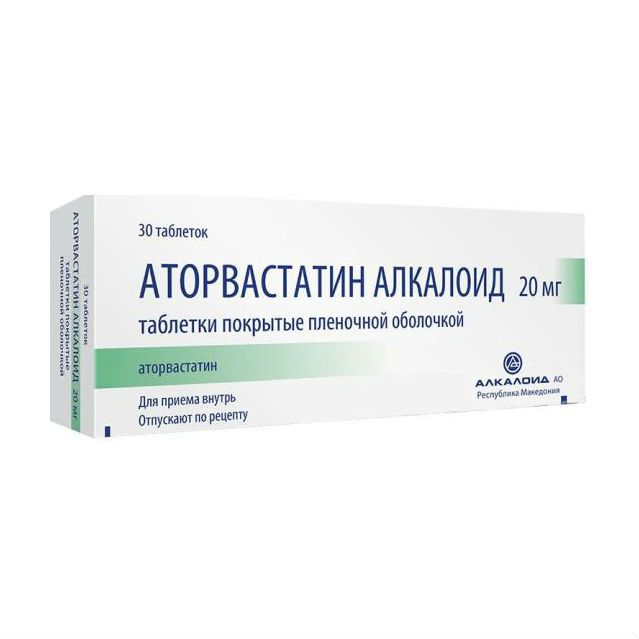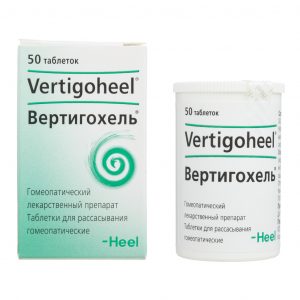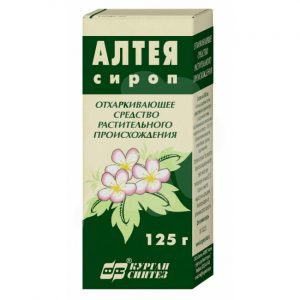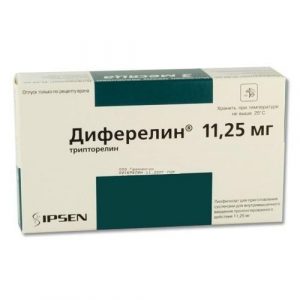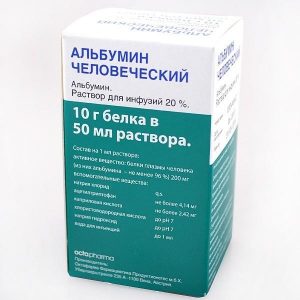Description
Pharmacological action of
Pharmacodynamics of
Atorvastatin is a selective competitive inhibitor of HMG-CoA reductase enzyme, which determines the maximum rate of cholesterol biosynthesis, which is responsible for the conversion of 3-hydroxy-3-methyl-glutaryl coenerosene A to pre-cholesterol. In the liver, triglycerides and cholesterol are included in the composition of very low density lipoproteins (VLDL), enter the blood plasma and are transported to peripheral tissues. Low-density lipoproteins (LDL) are formed from VLDL, which are catabolized primarily through interaction with high-affinity LDL receptors.
Atorvastatin reduces plasma cholesterol and lipoprotein levels by inhibiting HMG-CoA reductase and cholesterol synthesis in the liver, as well as by increasing the number of ² Ñhepatic ² Ñ LDL receptors on the cell surface, increasing LDL uptake and catabolism.
Atorvastatin reduces LDL production and LDL particle count. Atorvastatin causes a pronounced and persistent increase in the activity of LDL receptors in combination with favorable changes in the quality of circulating LDL particles.
Dose-dependently reduces the level of LDL in patients with homozygous hereditary hypercholesterolemia, resistant to therapy with other hypolipidemic agents.
Studies of the dose / effect ratio showed that atorvastatin reduces total cholesterol (by 30-46%), LDL cholesterol (by 41-61%), apolipoprotein B (by 34-50%) and triglycerides (by 14-33%), while simultaneously causing, to one degree or another, an increase in HDL cholesterol and apolipoprotein A. These results were similar in patients with heterozygous familial hypercholesterolemia, non-family forms of hypercholesterolemia and mixed hyperlipidemia, including patients with non-insulin-dependent diabetes mellitus.
Due to a decrease in the level of total cholesterol, LDL cholesterol and apolipoprotein B, the risk of cardiovascular disease is reduced and, accordingly, the risk of death is reduced. Studies of the effects of atorvastatin on cardiovascular morbidity and mortality have not yet been completed.
When using the drug in elderly patients with safety differences, the effectiveness or achievement of the goals of lipid-lowering therapy in comparison with the general population was not observed.
Pharmacokinetics
Absorption
After oral administration, atorvastatin is rapidly absorbed into the blood. The maximum concentration (Cmax) in blood plasma is reached within 1-2 hours, Cmax in women is higher by 20%, the area along the concentration-time curve (AUC) is lower by 10%, Cmax in patients with alcoholic cirrhosis increases 16 times , AUC – And. Eating slightly reduces the speed and duration of absorption of the drug (by 25% and 9%, respectively), however, lowering cholesterol is similar to that when taking atorvastatin without food. The absolute bioavailability of atorvastatin is approximately 12%, systemic bioavailability, which determines the inhibitory activity against HMG-CoA reductase, is 30%. Low systemic bioavailability due to presystemic metabolism in the mucosa of the gastrointestinal tract and with the “first passage” through the liver.
Distribution of
The average distribution of atorvastatin is approximately 381 liters. Communication with plasma proteins -98%.
Metabolism
Atorvastatin is metabolized primarily in the liver with the participation of isoenzymes CYP3A4, CYP3A5 and CYP3A7 of cytochrome P450 with the formation of pharmacologically active metabolites (ortho- and parahydroxylated derivatives, beta-oxidation products). In vitro, ortho- and para-hydroxylated metabolites have an inhibitory effect on HMG-CoA reductase, comparable to that of atorvastatin. The inhibitory effect of the drug on HMG-CoA reductase is approximately 70% determined by the activity of circulating metabolites.
Excretion of
Atorvastatin is excreted mainly with bile after hepatic and / or extrahepatic metabolism (does not undergo severe enterohepatic recirculation).
The elimination half-life is 14 hours. The inhibitory activity against HMG-CoA reductase persists for about 20-30 hours due to the presence of active metabolites. Less than 2% of an oral dose is determined in the urine. It is not excreted during hemodialysis.
Indications
In patients with primary hypercholesterolemia, heterozygous familial and non-familial hypercholesterolemia and combined (mixed) hyperlipidemia (types Pa and lib according to Fredrickson) in combination with a diet to reduce elevated levels of total cholesterol, LDL cholesterol apolipoprotein B and triglycerides and raising HDL cholesterol
for the treatment of patients with elevated serum levels of triglycerides (Fredrekson type IV) and patients with dysbetalipoproteinemia (Fredrekson type III), in whom diet therapy does not give adequate hypertension for family srd lower levels of total cholesterol and LDL cholesterol when diet therapy and other non-pharmacological treatments are not effective enough.
Contraindications
Hypersensitivity to the components of the drug
active liver disease or increased activity of liver enzymes of unknown origin (more than 3 times compared with the upper limit of normal)
liver failure (severity according to Child Pugh A and B classification)
pregnancy
lactation period
age under 18 years of age (efficacy and safety not established)
Caution: alcohol abuse, history of liver disease, severe electrolyte abnormalities alansa, endocrine and metabolic disorders, arterial hypotension, severe acute infections (sepsis), uncontrolled epilepsy, extensive surgery, trauma, and skeletal muscle disease.
Use during pregnancy and lactation
Atorvastatin is contraindicated in pregnancy and during breastfeeding.
It is not known whether atorvastatin is excreted in breast milk. Given the possibility of adverse events in infants, if necessary, use of the drug during lactation should decide on the termination of breastfeeding.
Women of childbearing age should use adequate contraceptives during treatment. Atorvastatin can be prescribed to women of reproductive age only if the probability of pregnancy is very low, and the patient is informed about the possible risk of treatment for the fetus.
Special instructions
Before starting therapy with atorvastatin, the patient should be prescribed a standard hypocholesterol diet, which he must follow during the entire period of treatment.
The use of HMG-CoA reductase inhibitors to lower blood lipids can lead to a change in biochemical parameters that impair liver function, Liver function should be monitored before starting therapy, 6 weeks, 12 weeks after starting atorvastatin and after each dose increase, and periodically, for example, every 6 months. An increase in the activity of ² Ñliver ² Ñ enzymes in the blood serum can be observed during therapy with atorvastatin. Patients with an increase in enzyme levels should be monitored until the enzyme levels return to normal. In the case of a persistent increase in the values ² ¹ ² ¹of alanine aminotransferase (ALT) or aspartate aminotransferase (ACT) to a level exceeding more than 3 times the upper acceptable limit, it is recommended to reduce the dose of Atorvastatin or discontinue treatment.
Atorvastatin should be used with caution in patients who abuse alcohol and / or have liver disease. Active liver disease or a persistent increase in the activity of aminotransferases of unknown origin serve as contraindications to the appointment of Atorvastatin.
Treatment with atorvastatin, like other HMG-CoA reductase inhibitors, can cause myopathy. The diagnosis of myopathy (muscle pain and weakness in combination with an increase in the activity of creatine phosphokinase (CPK) by more than 10 times compared with the upper limit of the norm) should be discussed in patients with common myalgia or muscle weakness and / or a marked increase in CPK activity. Patients should be warned that they should immediately inform the doctor about the appearance of unexplained pain or weakness in the muscles, if they are accompanied by malaise or fever. Atorvastatin therapy should be discontinued if there is a marked increase in CPK activity or in the presence of confirmed or suspected myopathy. The risk of myopathy in the treatment of other drugs of this class increased with the simultaneous use of cyclosporine, fibrates, erythromycin, nicotinic acid or azole antifungal agents. Many of these drugs inhibit the metabolism mediated by cytochrome P450 ZA4 and / or drug transport. Atorvastatin is biotransformed under the influence of CYP ZA4.
When prescribing atorvastatin in combination with fibrates, erythromycin, immunosuppressive agents, azole antifungal agents or nicotinic acid in hypolipidemic doses, the risk and expected benefit of treatment should be carefully evaluated and patients should be regularly observed to detect muscle pain or weakness, especially during the first months of treatment and during periods of increasing doses of any drug. In such situations, periodic determination of CPK activity can be recommended, although such control does not prevent the development of severe myopathy.
When using atorvastatin, as well as other drugs of this class, cases of rhabdomyolysis with acute renal failure due to myoglobinuria have been described.
Atorvastatin therapy should be temporarily discontinued or completely discontinued if there are signs of a possible myopathy or a risk factor for the development of renal failure due to rhabdomyolysis (for example, severe acute infection, arterial hypotension, serious surgery, trauma, severe metabolic, endocrine and electrolyte disturbances and uncontrolled seizures) .
Before starting atorvastatin therapy, it is necessary to try to achieve control of hypercholesterolemia by adequate diet therapy, increased physical activity, weight loss in patients with obesity and treatment of other conditions.
Influence on ability to drive a car and work with mechanisms No adverse effects of atorvastatin on ability to drive a car and work with mechanisms were reported.
Composition
One tablet contains:
Active ingredient:
atorvastatin 20 mg (in the form of atorvastatin calcium trihydrate 21.70 mg).
Core:
lactose monohydrate / microcrystalline cellulose (75%: 25%) 128.60 mg
calcium carbonate 45.28 mg
copovidone 4.40 mg crospovidone 8.80 mg
croscarmellose sodium 2, 20 mg
sodium lauryl sulfate 4.40 mg
silicon dioxide colloidal 1.32 mg
talc 1.10 mg
magnesium stearate 2.20 mg.
Shell:
Opadry white Y-1-7000 [hypromellose (E464) – 62.500% titanium dioxide (E 171) – 31.250% macrogol 400 – 6.250%] – 5.00 mg.
Dosage and Administration
Usually, the starting dose is 10 mg once daily. The dose varies from 10 to 80 mg / day. The drug can be taken at any time of the day once a day, regardless of food intake. Doses should be selected individually, taking into account the initial level of LDL cholesterol, the purpose of therapy and the patient’s response to treatment. At the beginning and / or during an increase in the dose of Atorvatatin, it is necessary to monitor plasma lipid levels every 2-4 weeks and adjust the dose accordingly.
Dose adjustment should be done at intervals of at least 4 weeks. The maximum daily dose is 80 mg.
For patients with established coronary heart disease (CHD) and other patients who have a high risk of cardiovascular complications, it is recommended that the following goals are used to correct lipid levels: LDL cholesterol less than 3.0 mmol / l (or less than 115 mg / dl) and total cholesterol less than 5.0 mmol / l (or less than 190 mg / dl).
Primary hypercholesterolemia and combined (mixed) hyperlipidemia
In most patients, the necessary control of lipid levels is provided by taking 10 mg of atorvastatin once a day. A significant therapeutic effect is usually observed after 4 weeks. With prolonged treatment, this effect persists.
Heterozygous familial hypercholesterolemia.
Treatment of patients should begin with the appointment of 10 mg of atorvastatin per day. Carrying out individual dose adjustment every 4 weeks, it should be brought to 40 mg / day. After this, you can increase the dose to a maximum level of 80 mg / day, or use the combined appointment of 40 mg of atorvastatin and sequestrant of bile acids.
Homozygous familial hypercholesterolemia
Assign in a dose of 80 mg once a day. In patients with renal failure.
Kidney disease does not affect the concentration of atorvastatin in plasma or the degree of decrease in lipids when it is used in connection with this, any dose adjustment in patients with kidney disease is not required.
In patients with liver failure.
In case of liver failure, a dose reduction or discontinuation of the drug may be required (see section “Special Instructions”).
Side effects
Most often (1% or more): insomnia, headache, asthenic syndrome, nausea, diarrhea, abdominal pain, dyspepsia, flatulence, constipation myalgia. Less often (less than 1%):
From the nervous system: malaise, dizziness, amnesia, paresthesia, peripheral neuropathy, hypesthesia.
From the digestive system: vomiting, anorexia, hepatitis, pancreatitis, cholestatic jaundice.
From the musculoskeletal system: back pain, muscle cramps, myositis, myopathy, myalgia, arthralgia, rhabdomyolysis.
Allergic reactions: urticaria, pruritus, rash, anaphylaxis, bullous rash, polymorphic exudative erythema (including Stevens-Johnson syndrome), Lyell syndrome, angioedema.
From the hemopoietic organs: thrombocytopenia.
From the side of metabolism: hypo- or hyperglycemia, increased activity of serum creatine phosphokinase (CPK).
Other: impotence, peripheral edema, weight gain, chest pain, secondary renal failure, alopecia, tinnitus, fatigue. Undesirable effects on the part of the gastrointestinal tract most often develop: constipation, flatulence, dyspepsia, abdominal pain, usually these phenomena wane as treatment continues. During clinical trials, drug withdrawal due to side effects was required in less than 2% of patients.
Drug interactions
The risk of myopathy when treated with HMG-CoA reductase inhibitors increases when used in combination with cyclosporine, fibrates, macrolide antibiotics (including erythromycin), azole antifungal agents, or nicotinic acid.
In some rare cases, these combinations cause rhabdoMiolysis, accompanied by renal failure due to myoglobinuria. Concerning, a careful assessment of the risk ratio and the benefits of combination treatment is necessary (see section Special instructions).
Inhibitors of the isoenzyme of P450 CYP 3A4 pitochrome P450
Atorvastatin metabolism is carried out with the participation of the cytochrome P450 CYP 3A4 isoenzyme. When using atorvastatin in combination with cytochrome P450 CYP ZA4 isoenzyme inhibitors (e.g., cyclosporine, macrolide antibiotics, e.g., erythromycin and clarithromycin, nefazodone, azole antifungal drugs, e.g., itraconazole, and HIV protease inhibitors), drug interactions can occur. With the combined use of drugs, elevated plasma concentrations of atorvastatin may be noted. In this regard, special care should be taken when using atorvastatin in combination with the above drugs (see section Special instructions).
Concomitant use with drugs that reduce the concentration of endogenous steroid hormones (including cimetidine, ketoconazole, spironolactone) increases the risk of lowering endogenous steroid hormones (caution should be exercised).
P-glycoprotein inhibitors
Atorvastatin and its metabolites are substrates for P-glycoprotein. P-glycoprotein inhibitors (e.g., cyclosporine) may increase the bioavailability of atorvastatin.
Erythromycin, clarithromycin
With the simultaneous use of atorvastatin and erythromycin (500 mg 4 times / day) or clarithromycin (500 mg 2 times / day), which inhibit cytochrome P450 ZA4, an increase in the concentration of atorvastatin in the blood plasma was observed.
With the simultaneous use of atorvastatin / 10 mg once / day. ) and azithromycin (500np 1 time / day.) the concentration of atorvastatin in blood plasma did not change.
Itraconazole
With the combined use of atorvastatin at a dose of 40 mg and itraconazole at a dose of 200 mg once a day, an increase in AUC was detected to a level that exceeded the norm three times.
protease inhibitors The concomitant use of atorvastatin with protease inhibitors known as cytochrome P450 ZA4 inhibitors was accompanied by an increase in plasma concentrations of atorvastatin.
Grapefruit juice
Grapefruit juice contains at least one CYP3A4 inhibitor ingredient and may cause an increase in plasma concentrations of those drugs metabolized by CYP3A4. The daily intake of 240 ml of grapefruit juice increased the AUC of atorvastatin by 37% and decreased the AUC of the active orthohydroxy metabolite by 20.4%. The consumption of a large amount of grapefruit juice (more than 1.2 liters per day for 5 days) increased the AUC of atorvastatin 2.5 times, and the AUC of active inhibitors of HMG-CoA reductase (atorvastatin + its metabolites) – 1.3 times. In this regard, the consumption of large quantities of grapefruit juice during treatment with atorvastatin is not recommended.
Inductors of cytochrome P450.
Exposure to drugs inducing the cytochrome P450 isoenzyme CYP ZA4. (eg, rifampicin and phenazone) known atorvastatin. Interactions with atorvastatin and other substrates of this isoenzyme are unknown, however, the possibility of these interactions should be considered when using drugs with a low therapeutic index – in particular, class III antiarrhythmic drugs, for example, amiodarone.
Gemfibrozil / Fibrates
The risk of myopathy caused by atorvastatin may increase with the concomitant use of fibrates. In vitro studies indicate that gemfibrozil can also interact with atorvastatin by inhibiting eiro glucuronidation, which may cause an increase in plasma concentrations of atorvastatin (see Special instructions).
Digoxin
With repeated use of digoxin and atorvastatin at a dose of 10 mg, the equilibrium concentration of digoxin in the blood plasma did not change. However, when using digoxin in combination with atorvastatin at a dose of 80 mg / day. the concentration of digoxin increased by about 20%. Patients receiving digoxin in combination with atorvastatin should be observed.
Oral contraceptives
Taking atorvastatin in combination with an oral contraceptive containing norethisterone and ethinyl estradiol caused an increase in plasma concentrations of norethisterone and ethinyl estradiol. These concentration increases should be considered when choosing doses of oral contraceptives. With the simultaneous use of atorvastatin and a contraceptive for oral administration containing norethisterone and ethinyl estradiol, a significant increase in the AUC of norethisterone and ethinyl estradiol was observed by about 30% and 20%, respectively. This effect should be considered when choosing an oral contraceptive for a woman receiving atorvastatin.
Colestipol
With the introduction of colestipol in combination with atorvastatin, a decrease in plasma concentration of atorvastatin by approximately 25% was noted. However, with the combined use of atorvastatin and colestipol, the effect on lipids was more pronounced than when using each of these drugs separately.
Antacids
With oral administration of atorvastatin and a suspension containing magnesium and aluminum hydroxide, the concentration of atorvastatin in plasma decreased by about 35%, however, the degree of decrease in LDL levels did not change.
Warfarin
When taking atorvastatin in combination with warfarin, there was a slight decrease in prothrombin time in the first days of taking atorvastatin, however, in the next 15 days the prothrombin time indicator returned to normal. Nonetheless, in case of combined use of atorvastatin and warfarin, patients should be carefully monitored.
Phenazone
With the simultaneous use of atorvastatin does not affect the pharmacokinetics of phenazone, therefore, interaction with other drugs metabolized by the same cytochrome isoenzymes is not expected.
cimetidine
A study of the combined administration of cimetidine and atorvastatin did not reveal a significant interaction between these drugs.
Amlodipine
With the combined administration of 80 mg of atorvastatin and 10 mg of amlodipine, no changes in the pharmacokinetic parameters of atorvastatin in the equilibrium state were detected.
Other
No clinically significant adverse effects of atorvastatin and antihypertensive agents have been observed. Interaction studies with all specific drugs have not been conducted.
Atorvastatin did not have a clinically significant effect on the concentration of terfenadine in the blood plasma, which is metabolized mainly by cytochrome P450 ZA4, in this regard, it seems unlikely that atorvastatin can significantly affect the pharmacokinetic parameters of other substrates of cytochrome P450 ZA4.
Overdose
There is no specific antidote. In case of an overdose, the necessary symptomatic and supportive therapy should be carried out.
Monitoring of liver function and serum CPK levels is necessary. Hemodialysis is ineffective.
Storage conditions
At a temperature not exceeding 30 ° C.
Keep out of the reach of children.
Expiration
2 years.
Deystvuyuschee substances
Atorvastatin
Terms of delivery from pharmacies
Prescription
Dosage form
tablets
